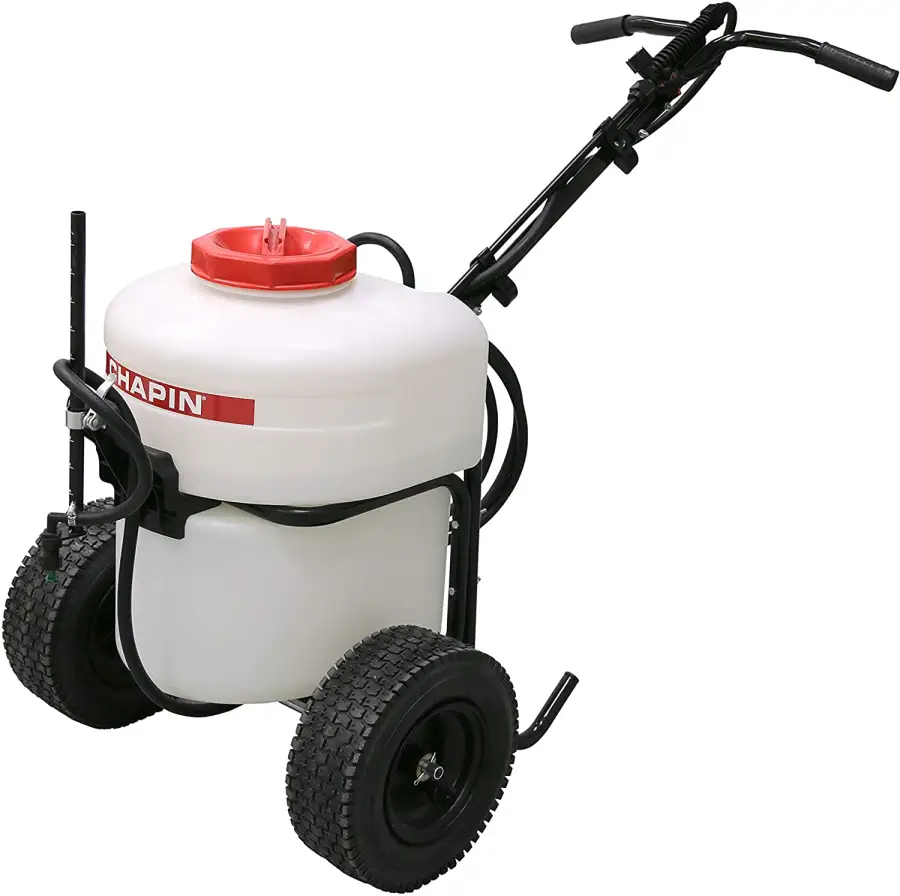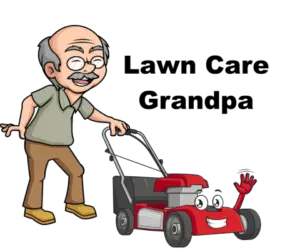If you’re new to the world of landscaping and agricultural equipment, you might have to play a bit of catch up with some of the terms. For many people, a “push sprayer” is one of the tools to get acquainted with. If you’re part of that uninitiated group, you’ve come to the right place.
Walk-behind, wheeled, or push sprayers are tools to carry and spread large amounts of herbicide, pesticide, or liquid fertilizer over larger areas than handheld sprayers can manage. Because of the weight of liquid, they can also be more efficient than backpack sprayers.
The following article is a deep dive into everything concerning push sprayers, including what they are, how they work, and what they are used for. We will also discuss the need for spraying, in general, as well as the various types of sprayers available to you. Let’s get to it!

Contents
What Is A Push Sprayer?
Before we discuss what a push sprayer is, we need to discuss why spraying is a necessity in the first place.
Push sprayers are tools that help deal with insect and weeds in areas from home lawns and gardens to farming plantations. While there are alternative solutions to such problems, most landscapers and farmers regard the use of chemicals to be the most convenient…and the most permanent.
Everyone knows that lawns, gardens, orchards, plantations, etc. are often susceptible to invasion by various weeds and animal pests. These unwelcome visitors bring a whole range of threats, including crop decimation, disease, and soil competition.
At the time of writing, there are innumerable herbicides, pesticides, fungicides, and soil treatments catering to a wide variety of problems. Additionally, there is a number of soluble fertilizers that are used to boost soil health and make your lawn, plants, and crops develop to their full potential.
However, for any of these chemicals to work correctly, there must be proper mixing and application.
This is where sprayers come in, especially where precision application is concerned. We don’t need to tell you that some of these agricultural chemicals cost a pretty penny, especially if we’re talking about industrial-scale farming or landscaping. Every drop counts, so efficient distribution is essential.
The word “sprayer” can refer to a whole range of liquid application technologies. In other words, there are different sprayers for different liquid volumes, work areas, operator capabilities (strength, height, physical impairment), and more.
Sprayers are (usually) made up of a tank (where the liquid that is to be sprayed is kept), a pumping mechanism, and a dispensing nozzle.
According to the Indian Ministry of Agriculture, sprayers are officially classified by the volumes they release over a given area of land. There are three main spray nozzle classifications, namely high volume (HV), low volume (LV), and ultra-low volume (ULV). HV nozzles dispense the largest droplets, while ULV nozzles release the tiniest drops.
If you are in the market for a push or trolley sprayer, I recommend this popular model that can be found on Amazon: PetraTools Battery Powered 13 Gallon Pushcart Sprayer
There Are Several Types Of Sprayers
Some, like the backpack knapsack sprayer and hand compression sprayer, are operated manually and carried around by the operator. Others, like tree sprayers and power knapsacks, are driven by engines. You also have equipment like tractor blower sprayers, which can serve as 3-point power takeoff (PTO) attachments for tractors.
However, our focus today is on the walk-behind sprayer aka push sprayer aka wheeled sprayer.
A typical push sprayer is made up of a large tank that is housed in a metal frame on wheels. There is a handlebar (or a pair of handles) that allows operators to push the sprayer like they would with a lawnmower.
These handy tools are popular because they offer much of a knapsack’s portability without any of the back pain.
The push sprayer design allows these tools to hold larger tanks than knapsacks. In fact, push sprayer tank volume can range from 5.2 gallons (20 liters) to over 13.2 gallons (50 liters). The wheels below the frame are designed to offer maneuverability and balance even when the tank is at full capacity.
The tank is connected to nozzles on a horizontal metal bar, known as a “boom” via a series of tubes. The number of nozzles varies, with some sprayers having one nozzle and others having up to 5-6. Aftermarket extension booms with more than eight nozzles are also common. The nozzles on some sprayer models can be opened or closed up for narrower or wider spraying.
A lot of push sprayers also have a lance sprayer attachment for spraying individual spots or elevated crops, bushes, or branches. Basically, they are used to spray anything the boom nozzles cannot access. These lance attachments are akin to those found on knapsacks and are often attached to long tubes that allow operators to spray areas the often-ungainly frame and tank cannot reach.
There are some other great articles on LawncareGrandpa.com here…
- PEX Irrigation System: Can You Bury PEX For Lawn Sprinklers?
- Does Roundup Expire Or Have A Shelf Life?
- Watering Plant Leaves Benefits: Mist Em, Spray Em, Soak Em
How Push Sprayers Work.
The spraying mechanism on these tools is either mechanical or electric. Mechanical push sprayers work by moving the wheels, which then activates a pumping mechanism in the tank. As long as the wheels are turning, the boom nozzle(s) will dispense the tank’s contents. If the operator stops pushing, the sprayer will stop spraying.
Electric push sprayers have an electric pump that is hooked up to a battery. These sprayers often have toggle switches or dials that allow operators to turn the spraying functions on or off.
What Are Walk Behind Sprayers Used For?
So, what are these things used for exactly? Well, push sprayers are quite versatile and can be used to apply all sorts of chemical liquids in all sorts of environments.
The most common use for push sprayers is in lawncare, where it can be used to spray weed killers, fungicides, and insecticides onto the grass. If you’ve ever enlisted a commercial landscaping company to help you with lawn vermin or diseases, chances are they used one of these at some point.
If you’re not a fan of mulching grass clippings back into the lawn after mowing, a push sprayer may be of use to you too. While clippings have the inherent risk of clumping, not mulching them could deprive your lawn of essential nutrients like nitrogen, phosphorous, and potassium.
With a sprayer, you can easily mix in soluble fertilizer and spray it into your lawn as a clump-free substitute.
Lance attachments can be used to apply chemicals to bushes and vegetables that are vulnerable to fungi, bugs, and sunburn.
Push sprayers are less efficient for working on established row crops because they are too bulky to traverse a field without damaging crops. However, lance attachments may be used to spray down crops along the edges.
You can also use a push sprayer to boost soil nutrition before your crops are planted. If you’re in between crops like this, a push sprayer is an efficient way to replace essential micronutrients like boron and magnesium.
The Final Touches On Walk-Behind Or Push Sprayers…
Walk behind sprayers or push sprayers help land owners with spraying pesticides, herbicides, and even liquid fertilizers. The reservoir holds whatever liquid needing to be dispersed and the wheels aid the person in maneuvering and holding straight lines.
Though they are mostly used on residential properties, there are instances they can be helpful on even larger farms. There are many possible uses for them and can be well worth the investment.
Here are some more great options for learning about lawn care…
- Can Old Motor Oil Fertilize Your Lawn?
- Should You Dissolve Fertilizer In Water?
- How To Deal With A Dandelion Infestation
References
https://farmer.gov.in/dacdivision/Machinery1/chap4.pdf
https://www.pitchcare.com/shop/pedestrian-sprayers/index.html

